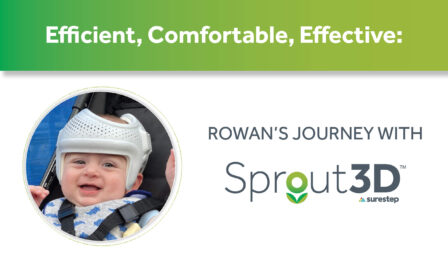Let’s Get Scientific About Surestep SMOs

Do Surestep SMOs really work?
Both practitioners and parents have asked that question. You could listen to testimonials. But the best way to find out is to put them on real kids and track the results.
The following is a summarized, plain-English version of a study conducted by Megan Smith, the Director of Clinical Research for Surestep. You can get the full study here.
What Was Measured?
First, it’s important to nail down the definition of “work.” All the kids in this study have hypotonia. Did the SMOs cure their low tone? No. Hypotonia cannot be cured or outgrown.
Instead, this study tracked gross motor skills. Typically, kids learn these skills (crawling, standing, walking, etc.) at a predictable pace.
But for kids with developmental delays, these milestones aren’t reached on time. And then the problem compounds on itself. If left untreated, kids with delays tend to fall further and further behind. But Surestep SMOs are designed to help kids gain those gross motor skills more quickly.
Essentially, the study asked one simple question: do Surestep SMOs help kids catch up with their peers?
Short answer, yes.

Who Was Involved?
18 of the kids recruited for the study followed through until the end. And they all had three things in common:
- Developmental delay
- Benign hypotonia
- Significant pronation
Since only kids with benign cases of hypotonia were included, none had an underlying diagnosis such as Down syndrome. The 18 kids were then split into two groups based on their initial level of gross motor skills:
Group One
This group was made up of 11 kids. On average, they were 15.8 months old. At the beginning of the study, they were able to pull to stand and cruise, but could not take independent steps. Compared to the gross motor skills of their peers, these kids were approximately 7 months behind.
Group Two
This group was made up of 7 kids. On average, they were 18.6 months old. At the beginning of the study, they were able to take independent steps. Compared to the gross motor skills of their peers, these kids were approximately 5 months behind.
How The Study Worked
An ABC certified orthotist fitted each child with Surestep SMOs, which they wore for the 16 weeks of the study. Every two weeks, the kids were recorded and gross motor skills were assessed. This allowed us to monitor when new skills were mastered.
The Results
So here’s what happened.
Prior to the study, the rate of change for gross motor skills was four times slower for Group 1 and two times slower for Group 2.
But after getting the Surestep SMOs, each group improved significantly. Both went from a deficient to accumulating gross motor skills faster than their typical peers.
The graphs below tell the story. The yellow line represents the average rate at which kids accumulate gross motor skills. The blue line represents the kids in the study. The further apart these lines are, the further behind the kids with hypotonia are behind their peers. The point at which the lines break is when kids received their Surestep SMOs. As you can see, when the study first started, the kids in our study were significantly behind. But in just 16 weeks, they nearly closed the gap.


Summary
To summarize, the data in this study suggests that Surestep SMOs improve gross motor skills. They aid kids with benign hypotonia, developmental delay, and significant pronation by helping them attain the same gross motor level as their peers.
Learn more about Surestep SMOs



